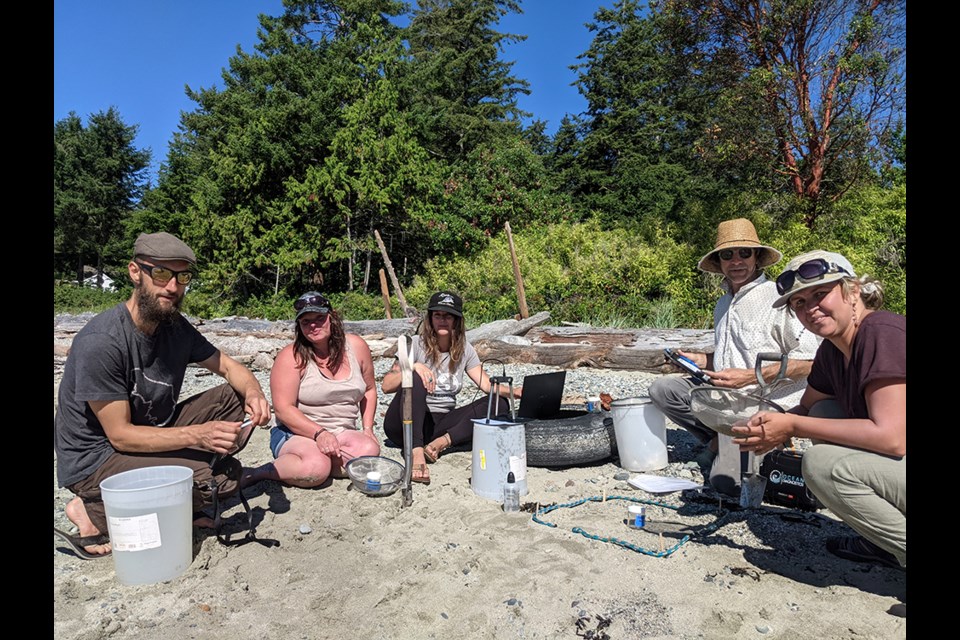Through efforts of dedicated crews, tonnes of material has been taken from qathet region beaches to be repurposed or discarded.
Let’s Talk Trash member Abby McLennan said that similar to last year, for provincial funding from the Clean Coast Clean Waters initiative, a project proposal was submitted under the umbrella of the Ocean Legacy Foundation, which was the successful proponent for the funding.
In the qathet region, McLennan said target areas for this summer included Saltery Bay up to Thunder Bay, Vanguard Bay on Nelson Island, northwest Texada Island and Okeover Inlet. She said work was being conducted on Savary Island, Hernando Island and up into Desolation Sound. Another project component is Lasqueti Island, which is separate.
“qathet Regional District is well-represented in cleanup areas,” added McLennan.
She said related to the project, there is a shoreline cleanup crew, an ocean plastics depot crew, vessel operators, cultural monitoring guides, a transportation service to transport materials, and also diversion specialists.
“All in all, there are about 31 jobs that have been created,” said McLennan.
She said through the diversion specialists this year, so far, more than four tonnes of material have been set aside. This year, 36,222 kilograms of material has been removed from the beaches, and 4,200 kilograms of that was diverted for reuse within the local community. Of the total collected, 15,625 kilograms have been sent to the Ocean Legacy Foundation facility for recycling. McLennan said the project is working to ensure the least amount of collected material ends up in landfill. She said a lot of styrofoam has been picked up off beaches.
“We’ve found almost three tonnes of styrofoam so far and that volume is significant,” said McLennan. “Styrofoam doesn’t weigh very much in comparison to how much space it takes up. When talking about landfill and sending this big, bulky styrofoam there, we actually have a capacity on what we are able to send, so without the Ocean Legacy Foundation, we are at risk of collecting more than our annual capacity that we can send.
“This is a continual problem in the marine debris world, with styrofoam not having provincial recycling programs, or really a plan in place other than relying on the Ocean Legacy Foundation to take it.”
Microplastics monitoring
McLennan said another new component that has been added into data collection is sandy shoreline microplastics monitoring. A control beach was selected that is relatively clean. It was sampled and then samples were taken at some catchment basins in the cleanup area. The samples will be analyzed by Ocean Diagnostics, which is a new environmental startup. The samples will be categorized into resin types and entered into a larger database to be used to help with policy and decision making, according to McLennan.
“In some of our monitoring we did find a lot of styrofoam nurdles at one location,” said McLennan. “There is a qathet Regional District resolution that will be going to the Union of British Columbia Municipalities convention in September, calling for all marine styrofoam to be banned for use in the marine environment. If that does come to fruition, it will be interesting to see the effect on our shorelines.”
McLennan said Fisheries and Oceans Canada has mandated that any leaseholders remove un-encased styrofoam and replace it with encased styrofoam or another alternative. She said, however, that about one-third of the styrofoam picked up this year in qathet is encased, so it’s still a problem. It smashes up on the shoreline and leaks out, she added.
“The regional district is asking that all styrofoam be banned,” said McLennan. “Hopefully, there will be some traction at the convention, and that it will be leveraged to the province, and then to the federal government to get some regulations around this problematic material.”
With four final collection days, McLennan estimated that more than 40 tonnes of material will be picked up off local beaches.
“It’s helpful to have large provincial funding because otherwise, it’s just basically up to the local tax base to address this issue, which doesn’t seem fair,” said McLennan.
She said she is pleased with the way the beaches have been cleaned up this year.
“We’ve had an incredible team, and great participation and collaboration with Tla’amin Nation,” said McLennan. “It’s made the work a lot easier to have such a great crew of people.”
McLennan added that there is a new petition to ban the use of styrofoam in the marine environment, which can be found online at petitions.ourcommons.ca; enter “qathet” in the search bar.



